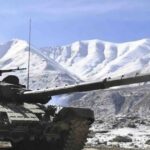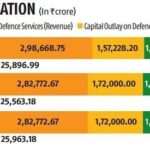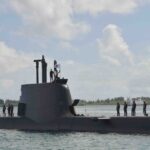
A Tejas Mark-1 comes in to land
By Vikas Gupta
Defence News of India, 1st Dec 23
Earlier this week, Prime Minister Narendra Modi became the first PM to be taken up for a sortie in the indigenous Tejas Mark 1 fighter aircraft. This display of confidence follows several ministry of defence (MoD) declarations that the shortfall of combat aircraft in the Indian Air Force (IAF) was being addressed through “Made in India” indigenous acquisitions. Even so, there is little reason to believe that the IAF’s fighter aircraft fleet would expand anytime soon from its current size of 30 squadrons to the 42-squadron fleet that MoD planners say is required to ward off the two large air forces of China and Pakistan. With each squadron comprising of 21 aircraft, the IAF faces a shortfall of more than 250 fighters. Add to that the navy’s shortfall of more than 50 fighter aircraft needed to fly from its two aircraft carriers, and the deficiency rises to over 300 fighters.
These shortfalls severely compromise the IAF’s ability to carry out its allocated wartime tasks. These include air defence, or safeguarding national airspace by damaging enemy airfields and radar installations, thus preventing the enemy’s air forces from inflicting damage on our own air infrastructure. Our deep interdiction capability would also be blunted, reducing our ability to destroy or damage the enemy’s road and railways infrastructure, ammunition and fuel depots and military headquarters. So too would be our capability for battlefield interdiction, or destruction of enemy military installations in and around the combat zone such as field headquarters, logistic installations and artillery gun positions. Finally, and most damaging, would be the erosion of our combat air support capability – or the IAF’s direct fire support to operations by our ground forces.
This capability gap has developed over decades. Given the progressive delay in our indigenous Tejas light combat aircraft (LCA) programme, the IAF issued a global tender in 2007 for 126 medium multi-role combat aircraft (MMRCA). Six of the world’s top original equipment manufacturers (OEMs) of fighter aircraft responded enthusiastically with offers. These included four twin-engine fighter manufacturers: Boeing with its F/A 18E/F Super Hornet; Russian Aircraft Corporation with the MiG-35, Eurofighter GmbH with the Typhoon and Dassault with the Rafale. In addition, two single-engine aircraft were offered: Lockheed Martin’s F-21 and Saab’s new Gripen E. However, this tender fizzled out in June 2016 into a government-to-government contract for 36 Rafale fighters, which are currently being delivered to the IAF.
Since this half-hearted measure failed dismally to address our shortfall of combat aircraft, the IAF issued a fresh tender in 2019 for 110 more fighter aircraft. All six OEMs from the aborted 2007 tender are likely to field improved variants of their MMRCAs. Another two fighter aircraft – Boeing’s F-15EX Eagle-II and Russia’s Sukhoi-35 – could be fielded by their OEMs in the current tender. The participation of these big, twin-engine fighters could raise the cost of the new contract to a prohibitive $15-20 billion. Furthermore, it could result in the entry of yet another fighter-type into the IAF, making inventory management an even greater logistics nightmare. The IAF chief warned last year that the air force already operates too many different aircraft, with origins in too many different countries. A new MRCA would constitute a seventh fighter type on its inventory.
Meanwhile, the IAF is struggling to shift its longstanding focus on hardware (combat aircraft) to a new set of enablers – software, data and artificial intelligence (AI). Drawing lessons from three recent conflicts – Azerbaijan-Armenia, Russia-Ukraine and Israel-Hamas – IAF planners have concluded that future wars are likely to be won by the side that ensures its networks remain secure and resilient, while constantly disrupting those of the enemy. This requires bringing to bear on the adversary all of one’s own economic, information and technological capability. Drawing on the US Air Force’s tactical combat theory, the IAF is working to shorten its “OODA loop”. This refers to the US combat tactics cycle of “Observe–Orient–Decide–Act”, or the time between a sensor’s detection of an enemy platform and a shooter’s destruction of that threat. The IAF will follow this sequence in dealing with the potent air threats that would emerge from China: Hypersonic, re-targetable, long-range missiles; and advanced early warning and control (AW&C) aircraft that would detect even low-flying IAF fighters at longer ranges. For that, the new generation of IAF aircraft would be required to carry faster missiles with longer ranges, faster processors for radars, and better data-link capabilities to coordinate the enhanced weaponry that it would field in the air battle. The IAF’s combat capability would require continuous upgradation, which means designing it ab initio with adequate physical space, computing infrastructure, structural strength and engine power.
Meanwhile, the navy too is grappling with that crucial element of fleet design: The need to minimise fighter-types. Last July, instead of buying the Boeing Super Hornet for aircraft carrier operations – which comes with significant advantages, such as furthering operational partnership with the US Navy – the MoD green-lighted an Inter-Governmental Agreement (IGA) with France for acquiring 26 Rafale Marine aircraft to fly from its aircraft carriers, along with ancillary equipment, weapons, simulators, spares, documentation, crew training and logistic support. In effect, the navy spurned US partnership for aircraft carrier operations and upgraded relations with the French instead. This has important connotations for the operational and equipment choices that the Indian Navy would soon be required to make in structuring its fleet, especially the question of a second indigenous aircraft carrier and the expansion of our submarine fleet – both conventional and nuclear-powered.
Even so, the air force day message from the IAF chief in October was one of reassurance and confidence, envisioning a combat aircraft build-up worth Rupees 2.5 to 3 lakh crore over the next 7-8 years. This includes contracts for Hindustan Aeronautics Limited’s high altitude-capable Prachand light combat helicopter, a larger fleet of 180 Tejas Mark 1A light fighters and 200 Mark 2 medium fighters for close to Rupees 1.75 lakh crores. The Tejas Mark 1A, already nearing development, would replace the obsolescent MiG-21 and MiG-27 fleets. Meanwhile, the larger and more powerful Tejas Mark 2 fighters, which could be expected in service by 2030, would replace the IAF’s three Mirage 2000 and six Jaguar fighter squadrons.
Taking a cue from the effective use of drones in recent conflicts, such as Ukraine’s use of them against Russian forces, the integration of unmanned aerial vehicles (UAVs) with manned systems is now a part of the IAF’s drone usage doctrine. So too is the development of countermeasures against hypersonic missiles, which have the potential to transform warfare. A positive factor in the IAF’s force structuring is its new acceptance of indigenous defence systems. “It is best to remain indigenous and not collaborate even if [development] takes time,” said the IAF chief.






